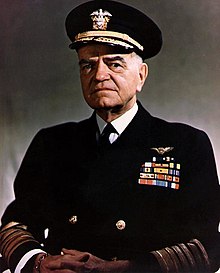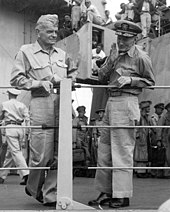William F. Halsey
William Frederick "Bull" Halsey, Jr. (born October 30, 1882 in Elizabeth , New Jersey , † August 20, 1959 on Fishers Island , New York ) was an American fleet admiral and during the Second World War in the Pacific commander of a fleet the US Navy .
biography
Family and education
Halsey was the son of a captain in the US Navy. He attended Pingry School , studied medicine at the University of Virginia around 1900 and graduated from the United States Naval Academy from 1900 to 1904 .
Military career
Halsey then served as an Ensign on battleships, where he was in 1909 Lieutenant (junior grade) and Lieutenant . He was then stationed on torpedo boats , which he commanded from 1912, from 1916 as Lieutenant Commander and commander of a torpedo boat flotilla.
First World War
During the First World War , Halsey commanded destroyers in the Atlantic that were tasked with escorting transport ships. During this time he already received high awards such as the Navy Cross , the second highest award in the Navy. In 1918 he became a commander ( frigate captain ).
From 1922 to 1925 Halsey worked as a naval attaché in Berlin , then he led two destroyer squadrons . In 1927 he was promoted to captain ( sea captain ) and commanded the aircraft carrier USS Saratoga in the mid-1930s , later the Naval Air Station Pensacola .
1938 was promoted to Rear Admiral ( Rear Admiral ) and 1940 to Vice Admiral . As such, he commanded the aircraft carrier forces of the US Pacific Fleet .
Second World War
At the time of the Japanese attack on Pearl Harbor , Halsey was on board the USS Enterprise , which was supposed to transport a load of aircraft to Wake Island Base . Due to adverse weather, the Enterprise came too late to attack Pearl Harbor.
During the first six months of the war, the "Task Force" led by Halsey carried out several air strikes on the Japanese- occupied Marshall Islands and the Enterprise under Halsey accompanied her sister ship Hornet under Captain Mitscher in the so-called Doolittle Raid , a bomb attack with B 25 Tokyo and other Japanese cities. However, at the time of the Battle of Midway , Halsey was in the United States for medical treatment due to a severe skin condition.
In October 1942, during the Battle of Guadalcanal , Halsey was appointed as the successor to Robert L. Ghormley to commander the US fleet in the South Pacific and promoted to Admiral on November 18, 1942 . In 1943 he took command of the newly formed 3rd US Fleet , which took part in the fighting for the northern Solomon Islands and in Operation Cartwheel under Halsey's command . The two admirals Halsey and Spruance took turns in 1944 and 1945 with their staff in the leadership of the Big Blue Fleet , which under Halsey functioned as the 3rd and under Spruance as the 5th fleet.
Halsey's leadership in the greatest naval battle of all time, the sea and air battle in the Gulf of Leyte in October 1944, was controversial . Through several wrong decisions, he cleared the way for the Japanese against the landing fleet and failed to inform his comrades of his decisions, which they made almost defenseless to inform at all. Nevertheless, his superior, Admiral Nimitz, Halsey left the fleet command.
The Task Force 38 of the US 3rd Fleet under Halsey's command came on 18 December 1944, around 200 miles east of the Philippines in the heavy Typhoon Cobra , capsized three destroyers, nine ships were heavily damaged, and 790 sailors were killed. The fleet was then still under Halsey's command in a few other battles, including attacks on land targets in the South China Sea and in the middle of the year in the attacks on the Japanese islands. On August 29, Halsey led the fleet aboard his flagship, the USS Missouri, into Tokyo Bay, where the surrender of Japan was signed on September 2 .
After the end of the war, Halsey was awarded the rank of Fleet Admiral on December 11, 1945 as the fourth and so far last officer in the US Navy .
retirement
In March 1947 he resigned from active service.
After his retirement he served on the boards of two subsidiaries of the International Telephone and Telegraph Company until 1957 .
In 1959 he died on Fishers Island (New York). He was buried in Arlington National Cemetery.
marriage
In 1909 he married Frances Cooke Grandy (1887–1968), called Fan. The couple had two children. Margaret Bradford (1910–1979) and William Fredrick Halsey III (1915–2003).
honors and awards
Honors
- The Navy named two ships after the admiral:
- Halsey Field, NAS North Island in Coronado , California
- Several buildings got his name u. a.
- Admiral William F. Halsey Jr. Leadership Academy in Elizabeth , New Jersey
- Halsey Hall, University of Virginia at Charlottesville , Virginia .
- Various streets were named after him
- He is ranked 21st in the Historical Ranking of Senior Officers in the United States .
Awards
He has been awarded a number of medals from the United States and various other nations. a.
- Navy Cross
- Navy Distinguished Service Medal
- Army Distinguished Service Medal
- Presidential Unit Citation
- Order of the British Empire
Movie
In the feature film Midway - For Freedom (2019) Halsey was portrayed by Dennis Quaid . The film covers the first six months of the Pacific War.
Trivia
- Paul McCartney means with Admiral Halsey in his song Uncle Albert / Admiral Halsey William F. Halsey.
- He was nicknamed "Bull Halsey".
- In Tom Clancy's novel The Hunt for Red October , the main character Jack Ryan is the author of a biography of Halsey and discusses his book and Halsey in a scene with a defected Soviet officer.
- Halsey's ancestors include John Halsey, who received a letter of insurer from the governor of Massachusetts during the Queen Anne's War . After the letter of piracy expired, he acted as a pirate off the East African coast .
- In the video games Wing Commander: Privateer and Wing Commander Arena , space stations of the Halsey class appear, namely the Perry Naval Base and the Farragut Naval Base, respectively.
- A street in Brooklyn and the corresponding stop on the L subway line (New York City) are named after Halsey . The singer Halsey named herself after this subway station .
literature
- Elmer B. Potter: Bull Halsey. A biography. Naval Institute Press, Annapolis MD 1985, ISBN 0-87021-146-3 .
- Walter R. Borneman: The Admirals. Nimitz, Halsey, Leahy and King - The Five-Star Admirals who won the War at Sea. Little Brown and Company, New York NY 2012, ISBN 978-0-316-09784-0 .
Web links
Individual evidence
- ↑ Borneman: Bull Halsey. A biography. Naval Institute Press, Annapolis MD 1985, 74 u. 90.
- ^ Walter R. Borneman: The Admirals. Nimitz, Halsey, Leahy and King - The Five-Star Admirals who won the War at Sea. 2012, p. 43.
- ↑ Handbook for Wing Commander Arena , Star * Soldier
| personal data | |
|---|---|
| SURNAME | Halsey, William F. |
| ALTERNATIVE NAMES | Halsey, William Frederick (full name); Halsey, Bull (nickname) |
| BRIEF DESCRIPTION | American admiral |
| DATE OF BIRTH | October 30, 1882 |
| PLACE OF BIRTH | Elizabeth , New Jersey |
| DATE OF DEATH | 20th August 1959 |
| Place of death | Fishers Island , New York |


